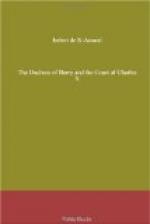“A moment in the camp—always in our hearts.”
Not far from there an altar had been erected under a tent before the royal tent. All the road from Chalons, opposite the lines, was covered with a shouting and cheering crowd. Charles X. was accompanied by the princes and a brilliant staff. The carriage of the princesses followed him. He distributed to the officers, sub-officers, and soldiers the crosses of the Legion of Honor which he had accorded to them. The review, which was magnificent, lasted from noon to 3 P.M. Before returning to the palace, the sovereign visited the bazaar established along the promenade of the lawn. He dismounted, and the princesses descended from their carriage to traverse the shops.
At five o’clock the cortege, which had set out at 10 A.M., returned to the palace. On each of the four nights that Charles X. passed at Rheims, the streets of the city were illuminated. It was clear weather, and by the light of the illuminations, amid the crowd in the streets, there were everywhere to be seen the generals, the officers of the King’s household, and the great personages of the court in grand uniform. Charles X. set out from Rheims the morning of June 1, and the city, after some days of dazzling pomp, resumed its accustomed calm. Things had passed off well, and the monarch was fully satisfied.
The poets had tuned their lyres. Barthelemy, himself, the future author of the Nemesis, celebrated in enthusiastic verses the monarchical and religious solemnity; Lamartine, future founder of the Second Republic, published Le Chant du Sucre ou la Veille des Armes; Victor Hugo, the future idol of the democracy, sang his dithyrambic songs. Yet, in this concert of enthusiasm there were some discordant notes. Beranger circulated his ironic song Le Sacre de Charles le Simple.
As for Chateaubriand, the most illustrious of the royalist writers, he was to close his chapter of the MSmoires d’outre-tombe as follows:—
“So I have witnessed the last consecration of the successors of Clovis. I had brought it about by the pages in which in my pamphlet, le roi est mart! Vive le roi! I had described it and solicited it. Not that I had the least faith in the ceremony, but as everything was wanting to legitimacy, it had to be sustained by every means, whatever it might be worth.”
XVI
THE RE-ENTRANCE INTO PARIS
Charles X. made a solemn re-entrance into Paris, June 6, 1825. According to the Moniteur, Paris was divided between a lively desire for the day to come and fear that the weather, constantly rainy, should spoil the splendor of the royal pomp. At the barrier of La Villette there had been erected amphitheatres and a triumphal arch. The streets were hung with white flags and the arms of the sovereign, with the inscription: “Long live Charles X.!




